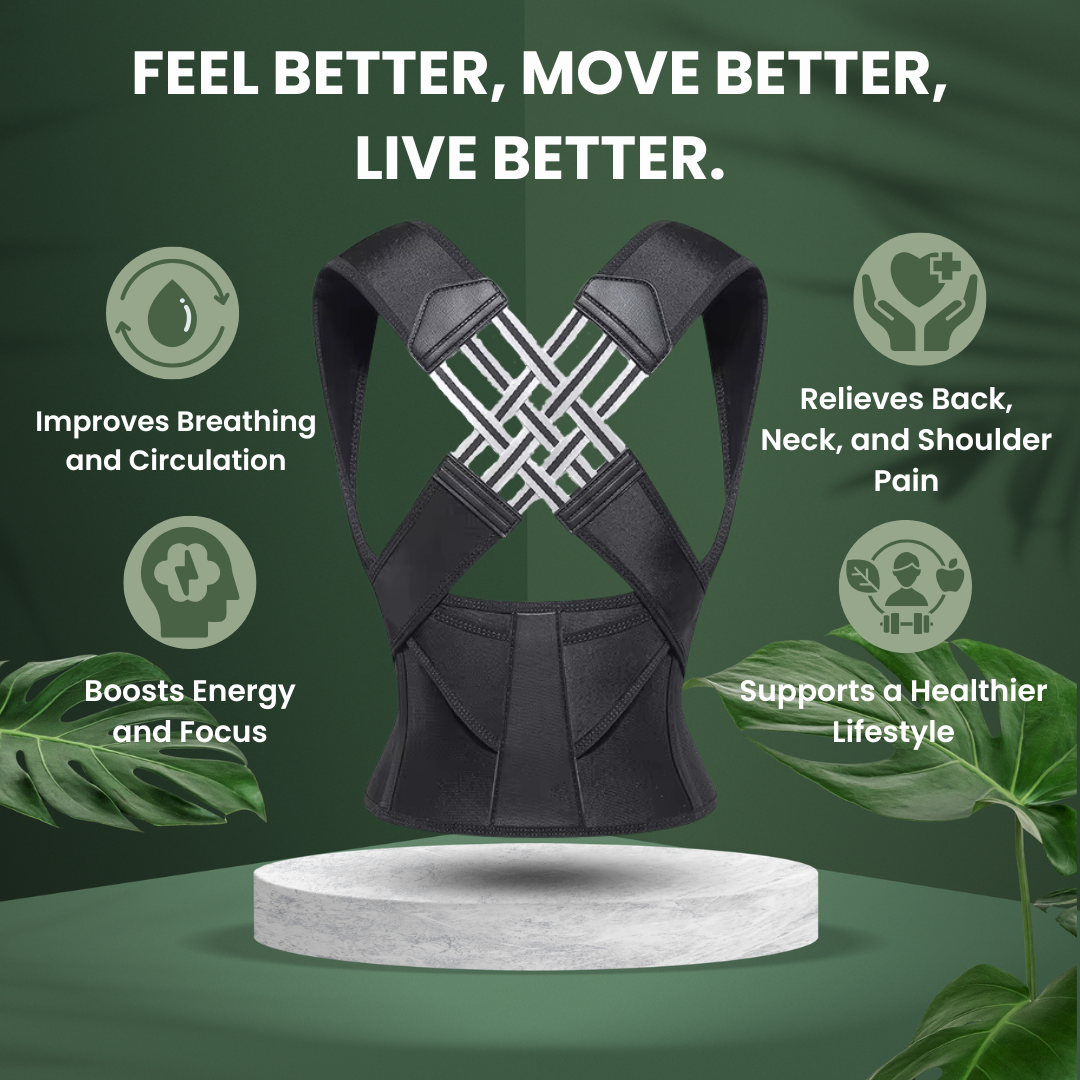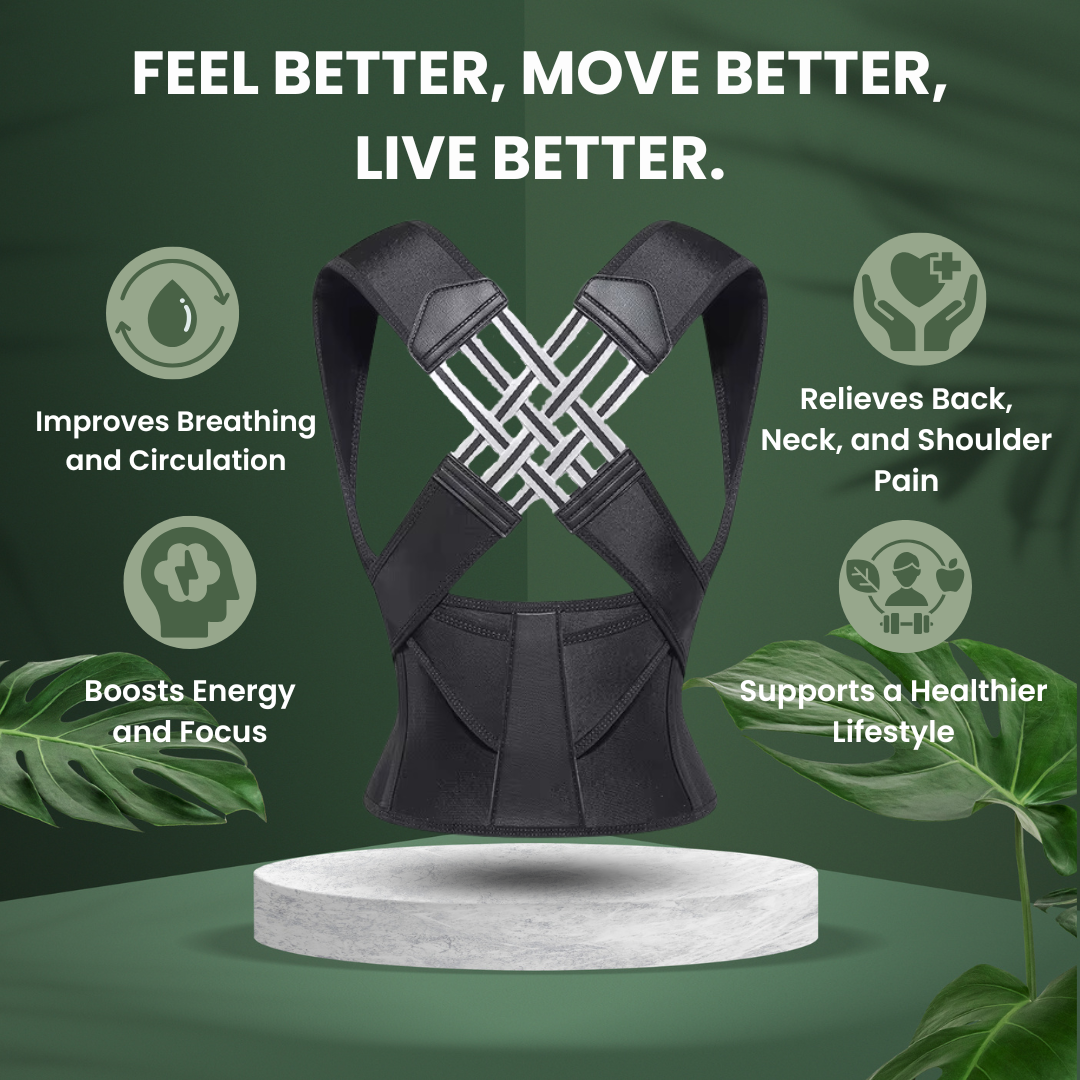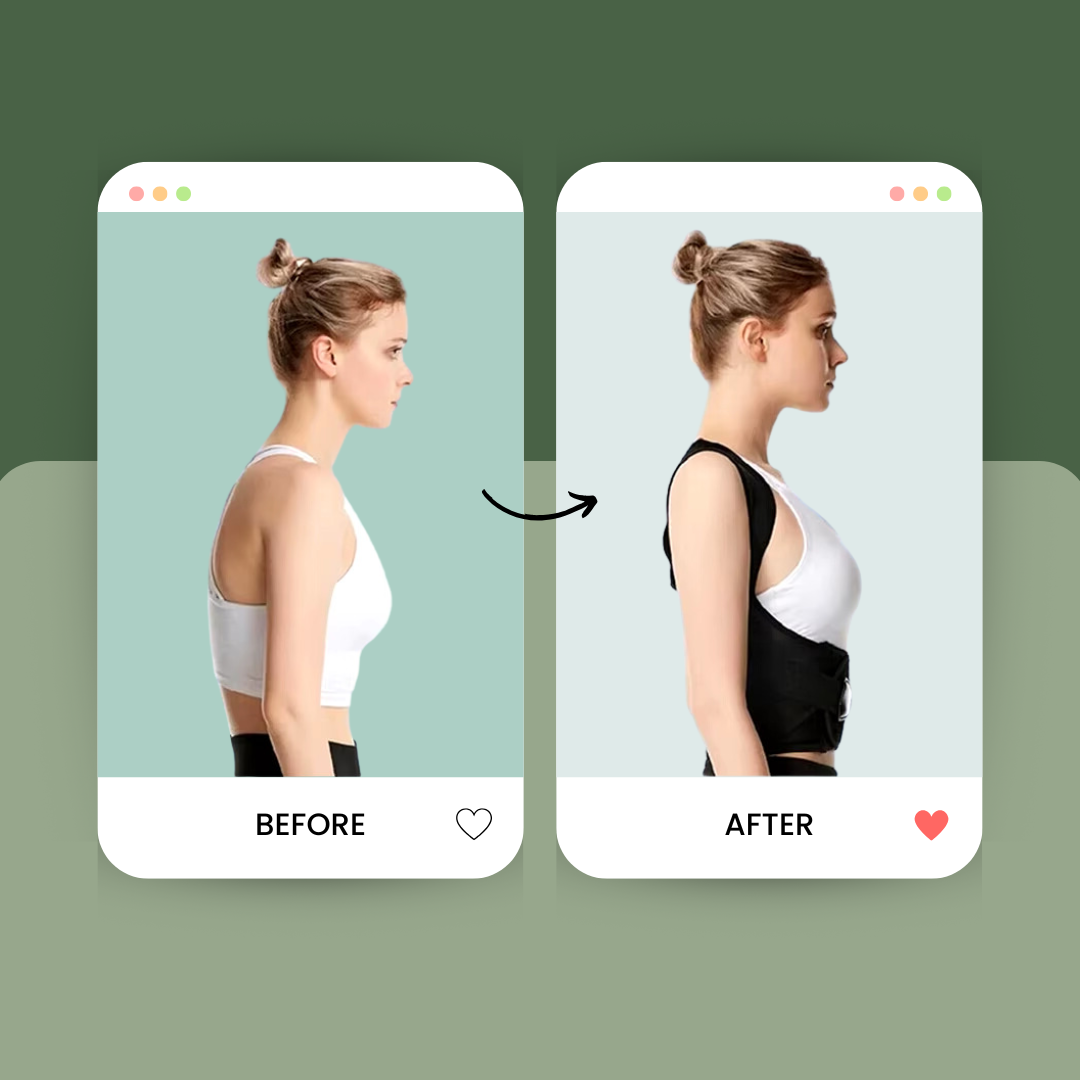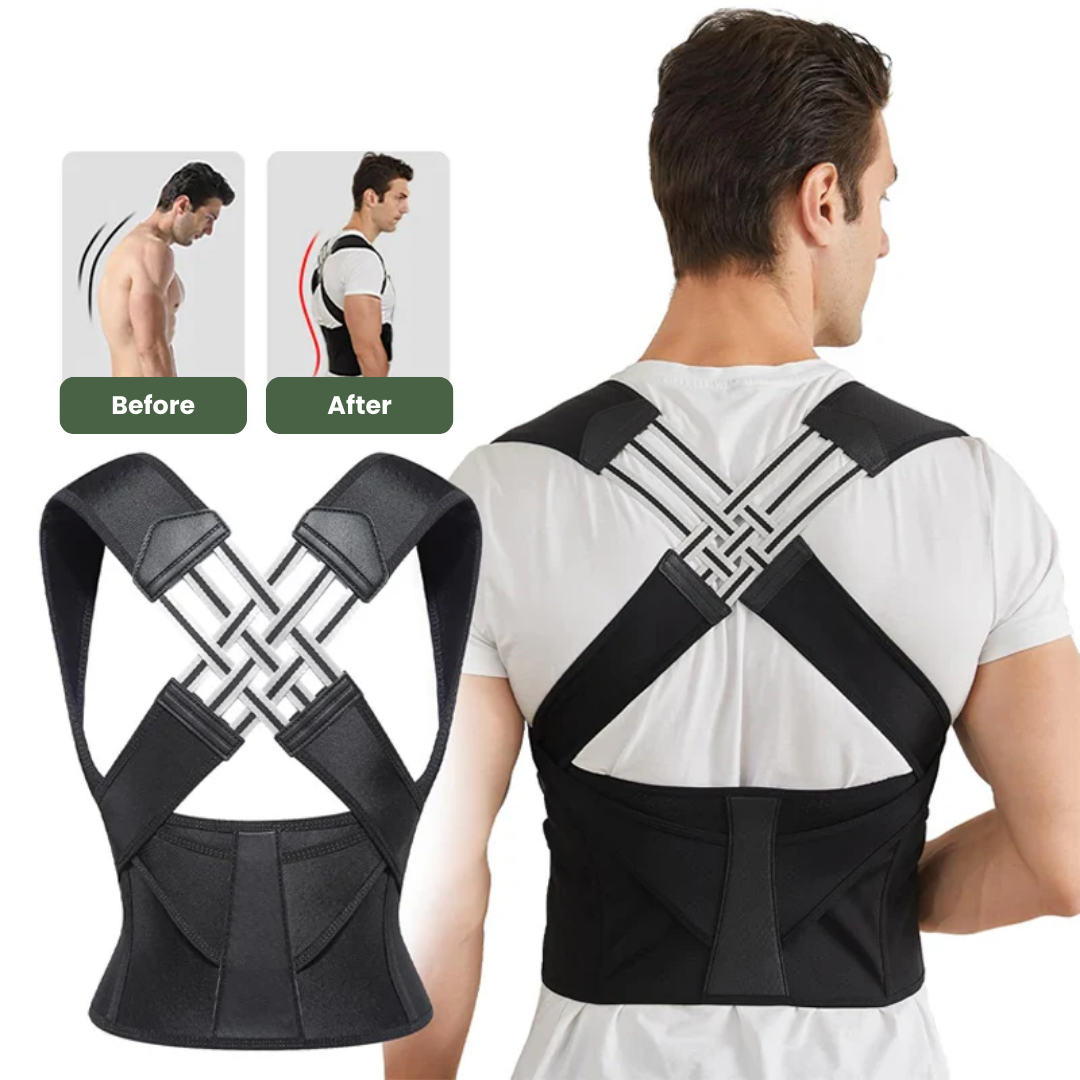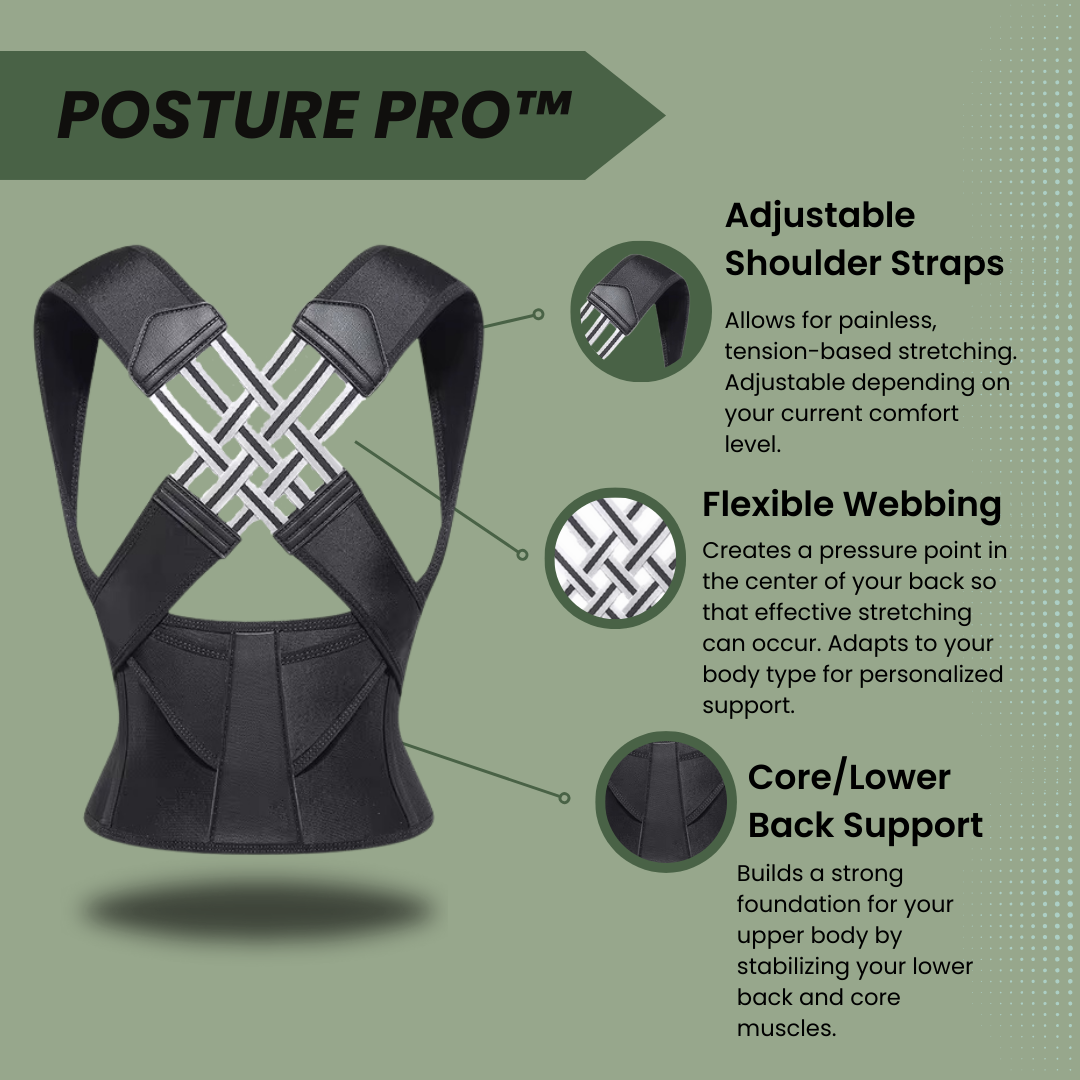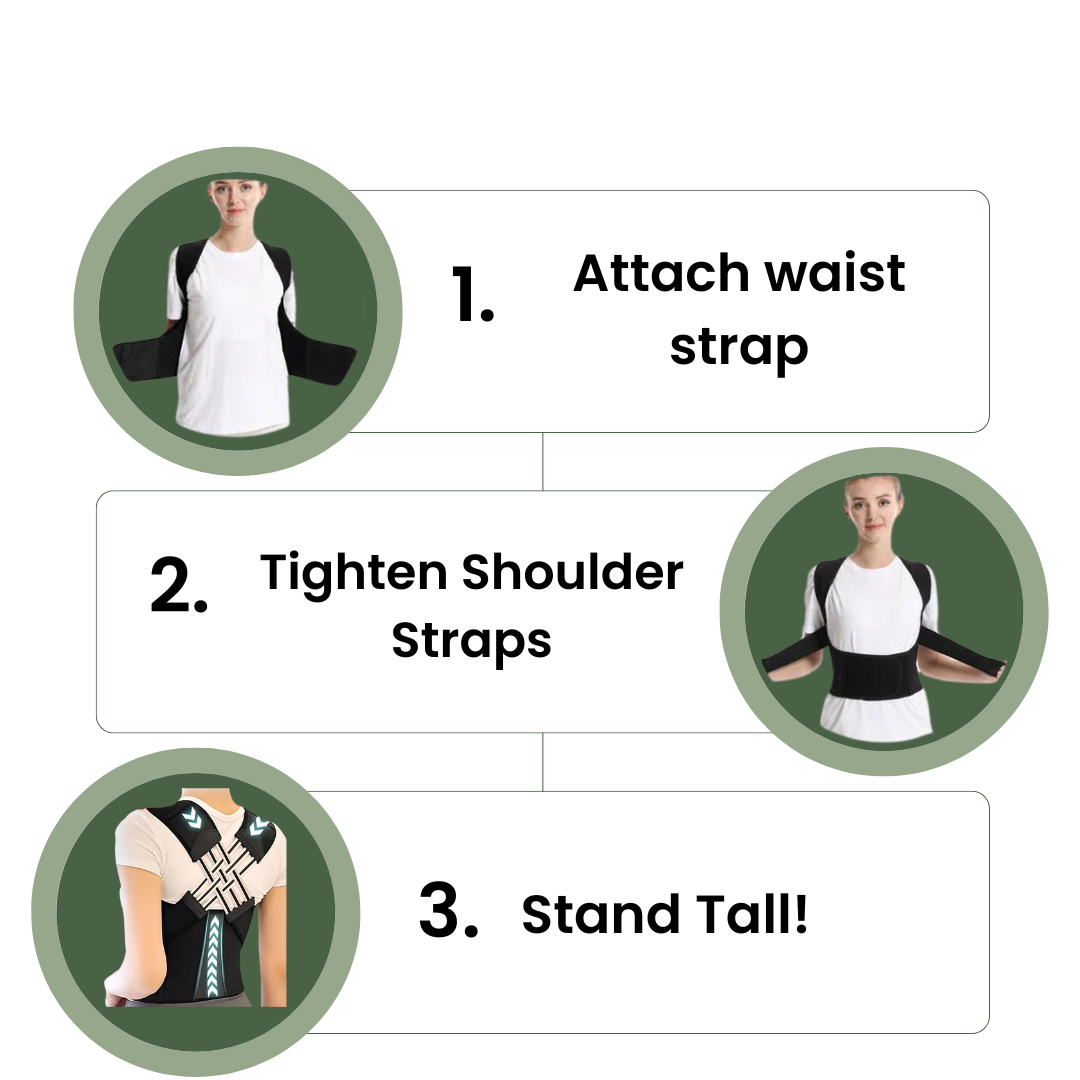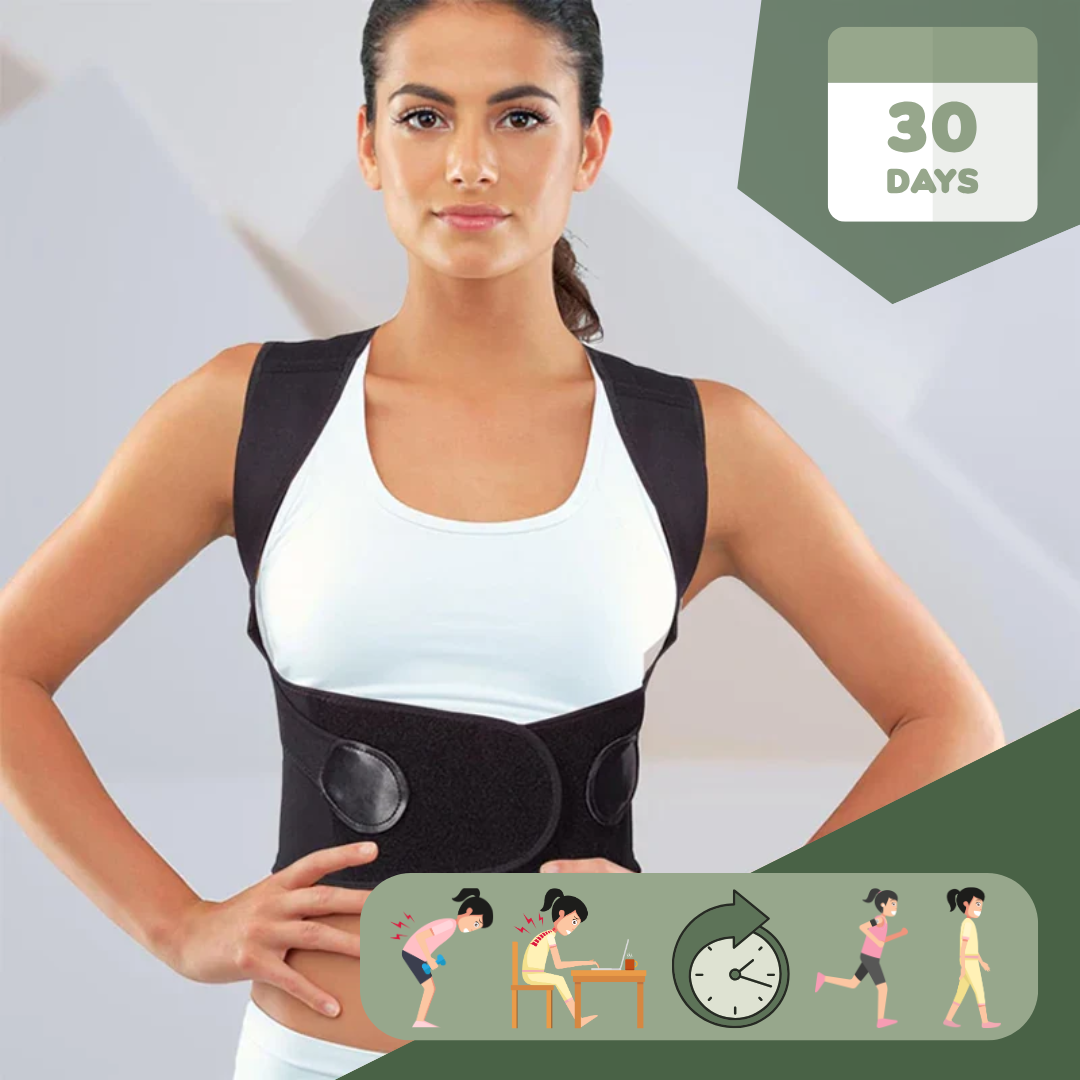Many of us sit at desks all day, and our backs start to hurt. This pain often comes from bad posture. Our guide will show you how the best posture corrector for work can help fix this.
Keep reading to feel better!
Key Takeaways
- Sitting wrong at work can cause back pain, neck pain, and headaches. Good posture keeps the spine straight and muscles balanced.
- Ergonomic chairs and desks help maintain good posture by supporting the lower back and keeping the computer screen at eye level.
- Slouching, forward head posture, and rounded shoulders are common issues from sitting too much. Using lumbar support or a back brace helps keep the spine straight.
- Posture correctors like shirts, magnetic devices, trackers, and cushions can help align your spine in the workplace. They should be comfortable and fit well for daily use.
- Doing stretches, core exercises, and desk-friendly yoga can improve posture at work. This reduces discomfort from poor posture.
Importance of Maintaining Good Posture in the Workplace
Maintaining good posture at work is crucial. It helps you avoid back pain, neck pain, and headaches. These problems can come from sitting wrong or standing badly for too long. Good posture keeps your spine straight and muscles balanced.
This means less body fatigue and better health overall.
Good posture is not just about standing tall; it's about maintaining the right balance and alignment to prevent injuries.
Ergonomic chairs and desks play a big role in this. They support your lower back and help keep your computer screen at eye level. This setup makes it easier to sit or stand correctly while you work.
Using these tools can lead to fewer aches, more energy, and higher productivity throughout the day.
Common Workplace Posture Issues

Common Workplace Posture Issues can lead to discomfort and health problems. Slouching, forward head posture, and rounded shoulders are common issues affecting office workers.
Slouching
Slouching is bending over in your chair. It is a big problem for people who sit a lot at work. Over 80% of jobs in the U.S. make workers sit too much. This leads to slouching and other posture problems like back pain and sciatica, which hurts your lower back and legs.
Yet, less than half of Americans worry about how bad posture affects them.
To fix slouching, keeping your spine straight is key. Kids and teens also feel back pain from looking down at screens too much. Using things like lumbar support or a back brace helps keep the spine straight.
These tools are made to help with slouching by supporting your lower back while you sit or stand at work.
Forward head posture
Forward head posture (FHP) is where your neck sticks out in front of your body. It's a common problem from sitting too long, like when you work at a desk all day. This bad habit can lead to pain and muscle issues because it makes your upper back work harder than normal.
People often get FHP without noticing until they start feeling the discomfort.
To fix or prevent this, using posture correctors might help. These devices, designed for lumbar support and spinal alignment, gently pull your shoulders back. They remind you to keep good posture by aligning your spine correctly.
Some even come with shoulder straps for extra support and are made of breathable material for comfort during long hours at the office chair. By wearing these while working, you give your neck and back the support they need to stay healthy and pain-free.
Rounded shoulders
Rounded shoulders are a common posture issue at work. It happens when the shoulder muscles become tight from staying hunched over for long periods, causing the shoulders to roll forward.
Prolonged sitting and poor ergonomics can contribute to this.
Regular movement and breaks during work can help prevent rounded shoulders by stretching and relaxing these muscles before they become too tight. When you sit down for extended periods, be mindful of your posture – straighten your back and keep your shoulders relaxed to minimize this problem.
Rounded shoulders occur due to prolonged hunching over, which causes the muscles in the shoulder area to tighten.
Tips for Maintaining Proper Posture
Adjust your chair and desk height to ensure your body is properly aligned, keeping your feet flat on the floor and positioning your computer screen at eye level. For more posture tips, check out our full article.
Adjust your chair and desk height
Ensure your desk height allows your wrists and arms to rest comfortably, angled down toward the lap. Also, make sure your chair supports your back correctly and conforms to the natural curve of your spine.
Position your monitor at eye level about an arm's length away to prevent neck strain. If you're shorter, consider using a footrest as it can improve posture and circulation by allowing your feet to rest flat on the floor.
Keep your feet flat on the floor
Sit with your feet flat on the floor for good posture. It's important for comfort and preventing health issues. If needed, use a footrest to ensure your feet stay flat, which can enhance your posture and blood circulation.
Align your back with your chair’s backrest
Sit with your back straight, aligned with the chair’s backrest. It's crucial to maintain a slight curve in your lower back while seated. Ensure there is enough lumbar support from the chair for proper posture.
Moreover, ensure that your feet are flat on the floor by adjusting the chair height. This will help you avoid slouching and contribute to maintaining good posture throughout the workday.
Ensure to adjust not just your seat but also your working environment and habits so that they support good posture as well.
Position your computer screen at eye level
Ensure your computer screen is positioned at eye level or slightly below, maintaining it around 30 degrees below your line of sight. This prevents discomfort and supports productivity in the workplace.
The optimal viewing distance from the screen should be approximately the length of your fully extended arm, promoting better posture and reducing strain on your neck and back.
When setting up your workstation, keeping these guidelines in mind can significantly enhance comfort and decrease the likelihood of experiencing posture-related issues throughout the workday.
Role of Posture Correctors in the Workplace
Posture correctors are designed to support and align the spine, shoulders, and neck, promoting proper posture throughout the workday. They can aid in alleviating strain on the back and neck caused by prolonged sitting or poor ergonomic setups.
How posture correctors work
Posture correctors work by engaging and training specific muscles to support a better posture. These devices, such as back braces or shoulder straps, pull the shoulders back and align the spine to encourage proper positioning.
They help alleviate discomfort in areas like the neck, back, and shoulders caused by poor posture. The use of these correctors also enhances proprioception, which is an increased awareness of body positioning.
Healthcare providers advise consulting before using posture correctors for severe alignment issues. It’s important to note that long-term use is discouraged; postural correctors should serve as training tools rather than permanent solutions.
Types of posture correctors for office use
Posture correctors specifically designed for office use are essential in promoting good posture and preventing discomfort. Here's a concise breakdown of the different types available:
- Posture shirts: These slim-fitting shirts provide gentle support to the back and shoulders, encouraging proper alignment without drawing attention.
- Magnetic posture correctors: Utilizing magnets strategically placed to improve spinal alignment, these devices discreetly guide the body into a healthier posture.
- Wearable posture trackers: These small, lightweight devices track posture and send gentle reminders to maintain better positioning throughout the workday.
- Posture cushions: These specially designed cushions add lumbar support to chairs, promoting a more natural spine curvature while sitting.
Using any of these options can help counteract the negative effects of prolonged sitting and contribute to overall well-being during work hours.
Exercises to Improve Posture at Work
Improving posture at work is crucial for long-term health. Incorporating simple exercises into your daily routine can make a noticeable difference in how you hold yourself throughout the day and alleviate any discomfort from poor posture.
Regular stretching, core strengthening, and desk-friendly yoga poses can help counteract negative effects of sitting for prolonged periods.
These exercises are key to correcting muscle imbalances caused by prolonged sitting or repetitive movements associated with workplace activities. They improve flexibility, strengthen core muscles, and promote spinal alignment, ultimately contributing to better overall posture.
Stretching routines for the neck and shoulders
Simple stretches can support in preventing or relieving stiffness and pain. First, lower your chin towards your chest for 15-30 seconds, feeling a stretch in the back of your neck. Then, rotate your head to each side for 15-30 seconds, feeling a stretch in the side of your neck and shoulder. Next, tilt your head toward one shoulder for 15-30 seconds, feeling a stretch in the side of your neck. Keep in mind to perform these exercises with gentle movements and deep breathing.
Core strengthening exercises
A strong core is crucial for body movements, promoting good posture and spinal alignment. Recommended exercises for core strengthening include Forearm Plank, Glute Bridges, Bird Dog, Dead Bug, and Bicycle Crunches. The Forearm Plank involves engaging the core and glutes by maintaining a push-up position.
- Forearm Plank: Engage your core and glutes by maintaining a push-up position.
- Glute Bridges: Raise your hips while lying on your back to engage the glutes and lower back.
- Bird Dog: From hands and knees, extend the opposite arm and leg for balance and stability.
- Dead Bug: Lie on your back, extend limbs towards the ceiling while engaging the core.
- Bicycle Crunches: While lying on your back, alternate bending sides to simulate a cycling movement while engaging the core.
These exercises are intended to prevent postural issues and maintain proper posture in the workplace environment.
Desk-friendly yoga poses
Desk-friendly yoga poses can help improve posture and reduce muscle tension. These simple exercises can be easily incorporated into your workday routine.
- Seated Chair Backbend: This pose opens the chest and supports the area below the shoulder blades, promoting better posture.
- Chair Lunge: Stretch the front of your thigh and hip while engaging your abdomen with this pose to strengthen and stretch muscles for better posture.
- Chair Twists: These stretches promote spinal mobility and relieve tension in the back, contributing to improved posture.
- Seated Forward Bend: Gently stretch your back and hamstrings by folding forward from a seated position, helping to release tension and improve posture.
- Seated Spinal Twist: This twist offers a gentle way to improve spinal mobility, relieve back tension, and enhance overall posture.
- Cat-Cow Stretch: Perform this gentle flow of arching and rounding your back in a chair to increase spinal flexibility and reduce stiffness related to poor posture.
- Neck Rolls: Perform slow, controlled neck rolls to release tension in the neck and shoulders caused by prolonged sitting, contributing to better overall posture.
- Wrist Stretches: Simple wrist stretches can alleviate tension built up from typing or using a mouse, helping maintain good posture throughout the workday.
Benefits of Maintaining Good Posture
Maintaining good posture can lead to reduced back and neck pain, increased productivity, and improved overall health. Proper posture also supports spinal alignment and shoulder positioning.
Curious to learn more?
Reduced back and neck pain
Reducing back and neck pain is crucial for workplace comfort and overall health. Ergonomic training aids in reducing chronic neck pain among office workers, with a prevalence ranging from 15% to 43.3%.
Combining ergonomic methods with therapeutic exercises leads to improved strength, function, and reduced pain. Lumbar support, posture correctors, and shoulder straps like ZSZBACE play an essential role in maintaining proper spinal alignment and reducing discomfort during work hours.
Increased productivity and focus
Sit-stand desks can boost productivity by 6.5%. Users stood for an average of 47 minutes daily, with higher outputs at specific times like 10:30-11:30 AM and 2:30-4:00 PM. Neck pain relief in 75% of users enhanced comfort and attention.
Improved overall health and well-being
Maintaining good posture at work contributes to overall health and well-being. It reduces the risk of developing back and neck pain, leading to improved physical comfort and reduced physical stress.
Good posture also promotes better breathing, allowing for deeper and fuller breaths, which benefits cardiovascular health. Moreover, it enhances confidence and energy levels, positively impacting mood and productivity.
By including simple adjustments in workplace ergonomics, people can experience these health benefits firsthand. Ensuring proper chair height, desk alignment, and computer screen positioning are key factors in maintaining good posture throughout the workday.
Additionally, engaging in exercises specifically designed to strengthen core muscles can significantly contribute to spinal stability, further enhancing overall well-being.
Choosing the Right Posture Corrector
When selecting a posture corrector, consider comfort and adjustability as crucial factors. Look for discreet designs suitable for workplace use to ensure it blends naturally with your attire and daily activities.
Consider comfort and adjustability
When selecting a posture corrector, comfort and adjustability are crucial. It's crucial to choose a corrector that feels comfortable when worn and can be adjusted to fit your body well.
The right fit and comfort significantly impact how effective the corrector will be for you. A properly fitting correctorencourages consistent daily wear, so it's essential to find one that matches your personal comfort preferences.
Various types of posture correctors address different comfort needs. This means you have options to discover one that provides comfort for you while still offering the required support for maintaining proper posture throughout your workday.
Look for discreet designs for workplace use
When selecting a posture corrector for workplace use, it's essential to look for inconspicuous designs that can be discreetly worn under clothing. For example, products like the Posture Pro™ are specifically crafted to remain unnoticed while providing the necessary support.
Furthermore, integrating lumbar support and adjustable straps in these inconspicuous designs ensures comfort and flexibility during long work hours.
Given the significance of maintaining professionalism in the workplace, choosing a posture corrector with subtle features such as breathable materials or a sleek silhouette is vital.
This allows individuals to benefit from improved posture without attracting unnecessary attention to their corrective measures.
Finally, devices such as the Upright Go have gained popularity due to their ability to remind users about their posture without being intrusive. By considering these factors, individuals can prioritize both their spinal health and workplace decorum at the same time.
Conclusion
Maintaining good posture at work is crucial for overall health and well-being. By making simple adjustments to your workspace and incorporating regular stretching exercises, you can promote back and neck comfort.
Posture correctors can also offer support in developing better habits, increasing productivity, and reducing discomfort. Prioritizing proper posture not only improves physical wellness but also enhances confidence and focus throughout the workday.
Keep in mind, small changes in how you sit or stand can make a significant difference in your everyday comfort and long-term health goals.
FAQs
1. What is the importance of maintaining good posture in the workplace?
Maintaining good posture at work is crucial to avoid back pain and neck pain. It ensures proper spinal alignment, which can prevent problems like rounded shoulders.
2. How can a posture corrector help improve my office posture?
A posture corrector or a back brace helps maintain proper spine and shoulder alignment by providing lower back support and lumbar support. They come with adjustable straps for comfort and are made from breathable material for all-day wear.
3. Are there any exercises that can aid in improving my workplace posture?
Yes, breathing exercises along with using tools like a yoga strap can greatly assist in improving your body shape, proprioceptive senses, and overall postural improvement.
4. Can poor workplace posture lead to serious health issues?
Absolutely! Poor workplace posture over time may lead to chronic back pain relief needs or even require consultation with a spine surgeon due to severe misalignment issues.
5. Where can I find quality products for maintaining proper office ergonomics?
You'll find many options online on platforms such as Amazon Prime where you could check out sports bras for women that provide great upper body support or backpacks designed specifically keeping spinal health in mind while carrying loads.
6. Do I need to make changes immediately if I have been practicing poor postures at work?
It's best not to delay making necessary changes once you've identified that you've slipped on maintaining good postural habits at work since it directly impacts your physical wellbeing.



